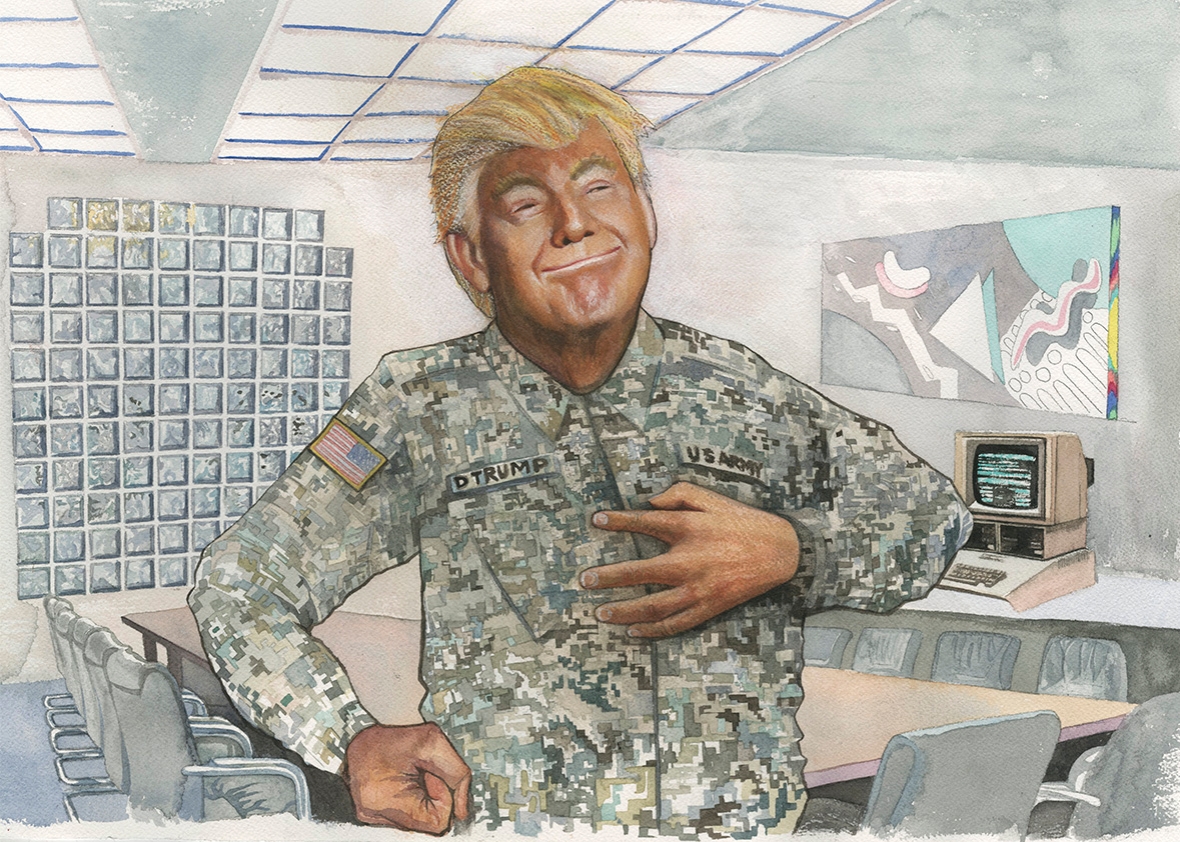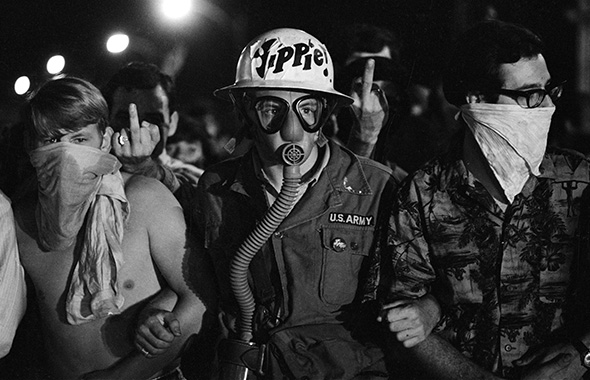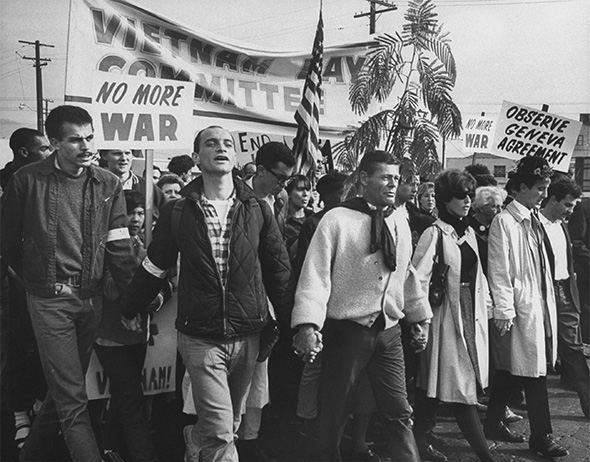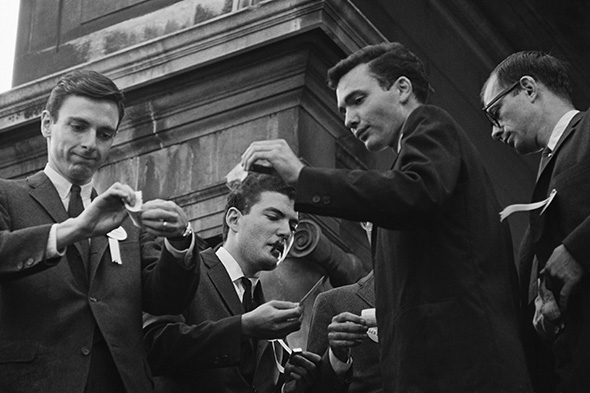Donald Trump, Baby Boomer
He wasn’t at Berkeley or Woodstock—and he definitely wasn’t in Vietnam—but Trump can only be understood as a terrifying product of his generation.

Michael Gaughan
It turns out the knack for selling “luxury” to people with no concept of value is the same as the one for selling “liberty” to people with no instinct for democracy. The key ingredient, in both salesmanship and demagogy, is authenticity, or the ability to be true to oneself without being the least bit truthful. Donald Trump is authentic the way Ronald Reagan was sincere. Reagan had the ability, as his own media consultant once said, “to convince himself that the truth is what he wants it to be. Most politicians are unable to do this, but they would give their eye teeth if they could.” Just as Reagan could tell a lie without troubling his conscience, so Trump is only more authentic the more he utters comical non sequiturs or outright fictions. What is uniquely appalling about Trump is not that he lacks civic virtue but that he draws mass appeal from its opposite, from an instinct for travestying civic norms, at which the man, it must be admitted, is an absolute maestro.
Little in Trump’s biography suggested he would grow up to lead a mass protest movement rooted in anti-establishment rage. How can a person who was handed such a plushy life speak so naturally to working-class resentments? How is it a man who inherited a fortune can so confidently reassure the Last—men and women who only a year or so ago he would have cheerfully called out as “losers”—that they, under President Trump, shall be First? Avoiding a lot of Rosebud doublespeak, I think we can trace Trump’s political instinct to a less personal, more sociological source. In this we need only look to his birth certificate. There we see that Donald John Trump was born on June 14, 1946. Is it possible Trumpismo, in its disdain for norms of speech and conduct, in its underlying craving for apocalyptic violence, is traceable to one simple fact? In almost plain sight, beneath the worldly swagger and breathtaking arrogance, lies Donald Trump the baby boomer.
Here is what I am not arguing: I am not arguing that Trump turned on, tuned in, and dropped out, that he stuck it to the man, that he smoked a skunky kush and freely loved. (Or whatever, pick your own cliché.) It is only one lamentable aftereffect of the ’60s that they cast their paisley mythomania on all related topics, not least upon the demographic journey of the baby boomers. One did not have to be at Berkeley, baiting the pigs on the steps of Sproul Hall, or even, really, to touch upon the counterculture at any of its points, to experience the deepest and most formative aspects of being a baby boomer. To understand how, it will help to pause for a moment and meditate on the idea of a generation.
Often when we say generation we mean something more like cohort. It is a revealing slip. A generation is, unlike a cohort, both a felt and an observable thing. It is “the biological rhythm of life,” says Karl Mannheim, the first theorist of the concept, “working itself out through the medium of social events.” The most obvious social events that convert a cohort into a generation, from merely demographic fact into poetic destiny, are revolution and war. The first fully modern idea of “a generation” comes from the First World War, when universal cataclysm interrupted the successive flow of generations by virtually wiping one out. Some survivors, following Ernest Hemingway (who borrowed it from Gertrude Stein, who apparently overheard it from a French garage mechanic) assumed the label “the Lost Generation,” a reference to their common affect of traumatized aimlessness. An intensely felt experience, cleanly demarcated in time, making distinct a unit of young people, for whom it is a unique bliss (or burden) to be alive—together these produce a generation.
This is precisely what did not produce the baby boomers. The baby boomers were made a generation by a war they did not fight; a war, in fact, they evaded fighting. Between the Gulf of Tonkin Resolution, in August 1964, and March 1973, when the last troops exited Saigon, 27 million young American men came of draft-eligible age. Of those 27 million, 11 million were called up, and only 1.6 million saw combat duty. In the ’60s, thanks to a brutal and unpopular war, draft evasion became something of a cottage industry. Medical doctors, dentists, psychiatrists—all were enlisted by middle-class parents to get their kids out of having to fight. In addition to the standard deferments, a young man with a high IQ, social connections, or a decent quantity of opportunistic cynicism could avoid being sent into combat, often simply by appearing respectable (haircut, yes sir, no sir) in front of a draft board.
Donald Trump’s selective service file reads as follows: Between 1964 and 1966, as American troop commitment in Vietnam escalated and the military draft began in earnest, Trump received three 2-S classifications—student deferments—for being enrolled at Fordham University and later at Wharton business school. In the ’60s, graduate school was an easy way to extend a student deferment until you turned 26, at which point you aged out of the draft. Unsurprisingly, graduate schools became wildly popular destinations in the ’60s. One survey showed 90 percent of MBA applicants were motivated by fear of conscription. Trump’s reasons for pursuing a business degree were, like anyone’s, surely mixed, but the real story lies in Trump’s two medical exams. In July 1968, Trump received a 1-A classification, signaling he was fit to serve on the basis of a physical he had taken roughly two years earlier. Then, in October 1968, Trump was examined again, and classified 1-Y. He was no longer protected by a grad student deferral, but it didn’t matter. He had been made exempt from military service due to an unspecified medical condition.
Not surprisingly, Trump has dissembled on the issue, claiming his high draft lottery number prevented a call-up. But Trump’s publicly available files show he received his 1-Y classification before the lottery went into effect, in 1969. When Trump’s biographer confronted him about the timeline, a curious exchange ensued. “As he talked, Trump slipped off his black loafer and pointed to his heel, where a little bulge pushed against his sock. ‘Heel spurs,’ he explained, ‘on both feet.’ ” By his own account, Trump was a golden boy athlete through high school, “always the best player” on the field, one who excelled “not just in baseball, in every sport.” Yet somehow, thanks to a minor protuberance, he was declared unfit for military service.
Trump’s identity as a boomer wasn’t made at Woodstock or Selma. Like most boomers who grew up in the ’50s, he is a member of his generation by virtue of having evaded service. But only next comes the defining move: After evading service, the boomer proclaims, against all the evidence, a personal authenticity rooted in a militarylike valor. Outside the Democratic convention hall in 1968, Norman Mailer flattered the legion of young protesters by telling them they “had the courage to live at war for four days in a city which was run by a beast,” referring to Mayor Daley and the thuggish Chicago police force, to which the assembled responded with a roar of absolute delight. Over and over, the author of The Naked and the Dead exhorted the protesters as fellow soldiers. This is only one high-profile instance: Read any first-person account of the protest movement, and you find young collegians prying themselves out from under the shadow of their low-status doubles, dying in Vietnam, by announcing themselves as warriors.

Roger Malloch/Magnum Photos
The students’ collective conscience had been provoked by the obviously discriminatory nature of the draft; but as the war escalated, and the horrors of fighting in it became evident, the emphasis shifted, as one contemporary put it, to “saving your own skin.” The system of deferments, exemptions, loopholes, technicalities, noncombat alternatives—it all overwhelmingly favored white children of privilege. Exalted generations of yore had come into romantic self-possession through war; the boomers’ martial fate was decided for them by social class, family connections, testable intelligence, and in some cases, sheer chutzpah.
The ignominy of evasion and campus bellicosity rose in tandem. Transitioning from the dignity and courage of the Freedom Riders to increasingly macabre acts of misbehavior undertaken for their own sake, campus leaders began to conceive of themselves in openly military terms. “Instead of marshaling his administration for war, [Clark Kerr] vacillated,” writes Jo Freeman disdainfully in her memoir, At Berkeley in the ’60s. “The activists were better prepared for war than Kerr.” Kerr, chancellor of the University of California–Berkeley, later noted dryly: “Most American students could not attack the White House or the Pentagon, but the home of the university or college president and ‘Old Main’ were right at hand.”
Whether with irony, chagrin, or pride, from the kids to their professors to Clark Kerr and, finally, to Gov. Reagan himself, warfare became the favored metaphor for the generational conflict playing out at Berkeley. And then, suddenly it wasn’t a metaphor anymore; and everyone got the fight they’d been spoiling for. When protests erupted over a patch of derelict land that Berkeley residents proclaimed the “People’s Park,” Reagan ordered in police officers from surrounding jurisdictions, authorizing the very force Kerr had so carefully avoided. Buckshot killed a bystander; caustic tear gas dumped from helicopters sent schoolchildren running for miles. Reagan himself commented: “Once the dogs of war have been unleashed, you must expect things will happen.” And: “If it takes a bloodbath, let's get it over with. No more appeasement.”
Vietnam had threatened to expose a university education, in theory open to anyone on his or her merits, as yet another class sanctuary; and yet, instead of with humility, a vocal subset of student leaders responded with strikes, sit-ins, filthy speech, arson, and bombs. These acts were ostensibly anti-war, but as every first-person account demonstrates, the target of the Berkeley protests was not, finally, the war in Vietnam. It was Berkeley. The protesters said so themselves, eloquently and repeatedly—the university was a bureaucratic, hierarchical “knowledge factory” whose gears ground down human individuality.
Their elders weren’t buying it. Both Clark Kerr and Kingman Brewster, his statesmanlike equivalent at Yale, openly speculated that the boomers greeted their greatest birthright—of a publicly funded university education—with violence out of a gnawing sense of guilt. The Vietnam War, after all, operated as a reverse meritocracy. At the height of the conflict, there were approximately 250,000 active American combatants, young men who had passed through a multilayered filtration system designed to remove anyone capable, as one historian put it, of making a “good impression.” At the very bottom of that pile were young men with no pull whatsoever. The baby boomer “generation” was turning out to be less a unitary phenomenon, less the oceanic “We” stretching from Port Huron to The Big Chill, than a gigantic sorting combine. It placed bright, ambitious, creative, coddled, middle-class kids out of harm’s way while sending young men of no social prospects whatsoever into the jungle to search and destroy.
Campus bad faith over Vietnam soon mingled with another novel social force. For more than 10 years, from the fateful day in 1960 that police opened up the fire hoses and washed protesting students down the marble steps of San Francisco City Hall to the Kent State shootings, the arrival of baby boomers into adolescence and young adulthood made the nightly news. As firsthand observers report, the small subgroup of protesters selected out for instant celebrity by the media was not the same as the dedicated and serious cadre that had led the movement prior to the media arriving on campus. After their arrival, though, the movement very quickly became a star system, rewarding the most mediagenic figures (Mark Rudd at Columbia, Mario Savio at Berkeley, Tom Hayden at the University of Michigan, and beyond) with camera time, and thereby legitimacy.
Most young people who went to college in the ’60s did so in the ordinary way. They went to classes, cheered at football games, fell in love, fell out of love, graduated, and moved on. It’s not important that the student protesters were not representative—in fact, it’s important that they were not. A small group of militant students in conjunction with an increasingly sensationalistic press created the impression of mass student unrest, and their self-interests fortuitously aligning, the two collaborated to make it seem as if a select group of campus stars spoke on behalf of masses of unrestful students.
Emphatically: The student protesters of the ’60s did not grow up to become the yuppies of the ’80s. However, I was amazed to discover, writing a book about the ’80s, how the basic template laid down in the campus pseudo-war at Berkeley persisted as the baby boomer generation moved into later adulthood. What is that template? A small and unrepresentative group of charismatics, seemingly lacking in healthy ego boundaries and without an even minimal respect for prevailing norms, wrests control of an institution from their elders, often by bypassing the established channels of bureaucratic authority, often by playing directly to the TV cameras.

Don Cravens/The Life Images Collection/Getty Images
Whether expiating guilt over Vietnam or imitating their more infamous peers, the boomers simply recreated the social dynamics of the campus war at Berkeley (and across the country) as they rose to prominence in the country’s more glamorous workplaces. Wall Street, party politics, academia, Hollywood—the prevailing leadership style shifted in the ’80s, from a managerial-professional elan, whispery and cool, to, as one contemporary observer put it, the “language of war.” Just as Mao’s Little Red Book or Albert Camus’ The Plague had been portable totems of authenticity in the ’60s, the paradigmatic “corporate warrior” of the ’80s carried on his person a copy of Sun Tzu’s The Art of War. The ancient Chinese martial how-to underwent quite a vogue over the decade; everyone from Michael Ovitz to Lee Atwater had one of its gemlike martial epigrams at the ready.
As did Donald Trump. The Art of the Deal borrows its title from The Art of War, and at the end of Trump 101: The Way to Success, Trump recommends you read only 10 books; there on the list, next to Machiavelli and Norman Vincent Peale, is Sun Tzu. Only a year or so ago, Trump tweeted out the Sun Tzu epigram “He who defends everywhere, defends nowhere.” Never one to settle for the garden-variety howler, Trump, who was shipped off to a posh military school as a teenager, has insisted, “I always felt I was in the military,” or “I always felt I was in the military in the true sense.” What did Trump do, when confronted by the actual sacrifice of John McCain? He simply negated it, ex tempore, with bluster. Thus Trump completed the boomer triple play: He evaded service; he nonetheless arrogates to himself the language of military valor; and he treats those who actually served as chumps.
So, in sum, the boomers were anti-establishment; they were norm-perverters; they were publicity hounds; and in their perversions and hounding, they covered themselves in their own supposed valor by announcing themselves as valorous. And yes, this description covers equally the Tom Hayden of 1968 and the Donald Trump of 1986. Still, why such rage?
It was none other than James Conant, president of Harvard and first evangel for the SAT, and, as much as anybody, father of the meritocracy, who lobbied against the student deferment in favor of universal military service. As one of his closest allies put it, “No one will be selected for military service except those too poor to afford to go to college, too stupid to stay there, or too lacking in initiative to avail themselves of some of the other manifold avenues by which military service can be avoided.” Anyone paying attention knew in 1951 where a student deferment would take the country. Why had Conant’s proposal for universal service been defeated? In his memoirs, Conant tells us. “The arguments of worried parents,” he laments, “proved more powerful with Congress than the reasoned opinions of the educators who supported [universal service].” The student deferment was simply another gift the middle-class boomer’s parents had given their children outright, and at the expense of their less fortunate peers. And this hit the boomers exactly where they lived.
The great majority of children born before, say, 1920 achieved economic selfhood by working, often as children. The boomers achieved economic power—enormous economic power, in fact—as consumers, and long before they acquired any as earners. Needing to be clothed, fed, and above all educated, they were little Keynesian pump-primers; and as they grew, the American economy grew with them. To the degree they were “sheltered,” it was not only from poverty, crime, industrial grit; they were sheltered from anything like the free market. Their childhood represented a massive and ongoing transfer of resources, both public and private, into child-rearing. The world they were born into was a suburban stage set. That stage set—its public roads, public streets, its schools, everything down to its public entrails, its gutters and sewers—had been subsidized, in one way or another, by the public purse. Almost half of suburban housing was underwritten by Federal Housing Administration or Department of Veterans Affairs financing. Onto the suburban stage set came the boomers, who completed the brochure of postwar fulfillment. They were the first generation to grow up in suburbia, a spatial and social arrangement without precedence in human history.
Does the conditioning environment of suburbia conduce a sense of well-being and life adjustment? Or of incipient terror, passivity, anonymity, feminization? Let’s agree to take that one on a case-by-case basis. In the meantime, I think it is fair to say that the boomers were burdened with a social destiny that was also an existential deficit. Born in such startling numbers (76 million between 1946 and 1964), they had been invoked as a “generation” before they could even walk. They had been told, from birth, that they represented a destiny; and yet, from birth, they were handed nearly everything in life. Their parents were unprecedentedly affluent and educated (the more professional the parents, and especially the more educated the mother, the higher the fertility rate), and committed in unprecedented numbers to creating child-centered homes. Is it any wonder the boomers keep reaching for a “social event” that will convert them from coddled children into a generation in Mannheim’s second, more poetic sense? That they must fight and refight ersatz wars? And is it any wonder that, if this is the archetypal boomer neurosis, Donald Trump’s is the most inflamed case?

Hiroji Kubota/Magnum Photos
Much is made of Fred Trump’s considerable legacy to his son but too little about when it happened. Trump inherited a portion of his father’s real estate empire, valued at $40 million, in 1974, in the middle of one of the most pitilessly soft job markets since the Great Depression. Among the chief factors making it soft were the boomers themselves. The expansion of the higher education system had been designed, in no small part, to delay their entry into the labor market. By 1974, delay was no longer possible. The 15–29 cohort hit 57 million; and this was not just a glut, but a labor glut, as recent college graduates poured into the American workforce. Each time the boomers advanced into a new age cohort, the employment rate and the earning power of that group declined.
Those relatively few boomers who emerged from the ’70s into the go-go ’80s with a paying job, much less a promising career, could claim victory in a Hobbesian war. But not Donald Trump. He’d emerged from the ’70s with a trust fund. For 35 years, he has insisted on his peerless business acumen, though the most sophisticated analysis indicates he was bequeathed a real estate empire, only to have its assets underperform the most humdrum of stock indexes.
Behind the Versailles-like trappings, Trump hides the fact that he is a below average investor. More pointedly, one could say that for Trump creating value in the economic sense has never been the goal and that putting his names on buildings, getting his name into the papers, and so on are better regarded as the conspicuous consumption items of a peculiarly American toff. Trump has the misfortune—and I say this without irony—of having grown up in a household whose wealth made self-making impossible but whose values were business values. The most telling image from a recent biography comes from the chapter titled “The Boy King.” Little Donald was forced into a paper route, but in bad weather was allowed to make deliveries via chauffeured limo.
Ur-boomer that he is, scarcely a sentence Trump utters could not be categorized as a compensatory boast and placed in one of four bins: I inherited nothing; I am a pure product of my own high aptitude; I am a warrior; and somewhat less obviously, though most consequentially, Together, at last, we will make a single generation. The first three are delivered with the usual belligerence of a man who believes the opposite of what he says. The final boast, however, is the most revealing. In addressing the white working class as would-be savior, Trump, chief beneficiary of boomer privilege, will make good to the victims of that privilege, to those Americans who have fought in our wars only to watch as their economic self-respect ships off to China. In Trump, we find all the false selves of a generation wrapped into one awful summa. His candidacy is a monstrous act of pseudo-healing, beneath which lies one man’s quest for a personal authenticity he can never, and will never, achieve.
